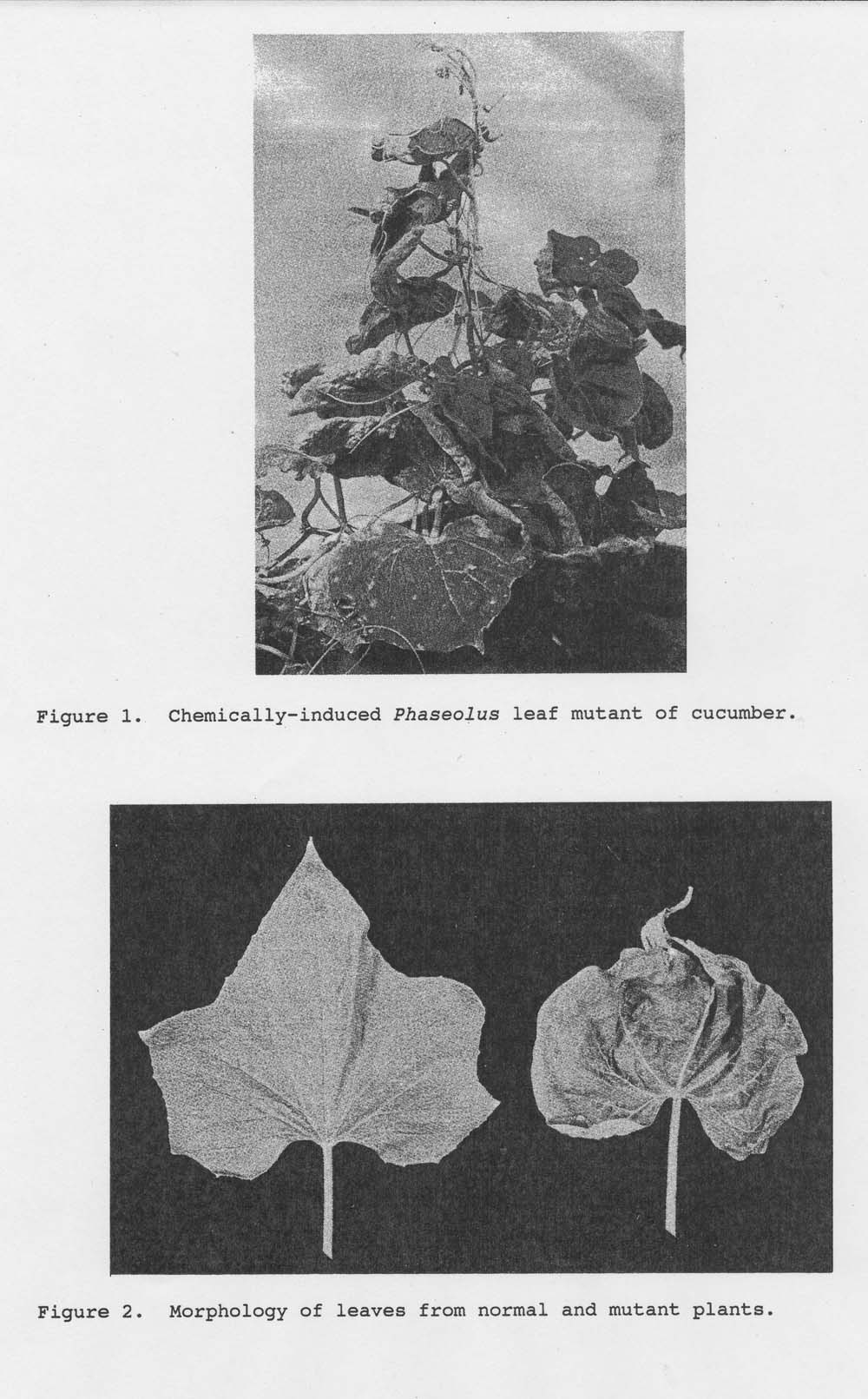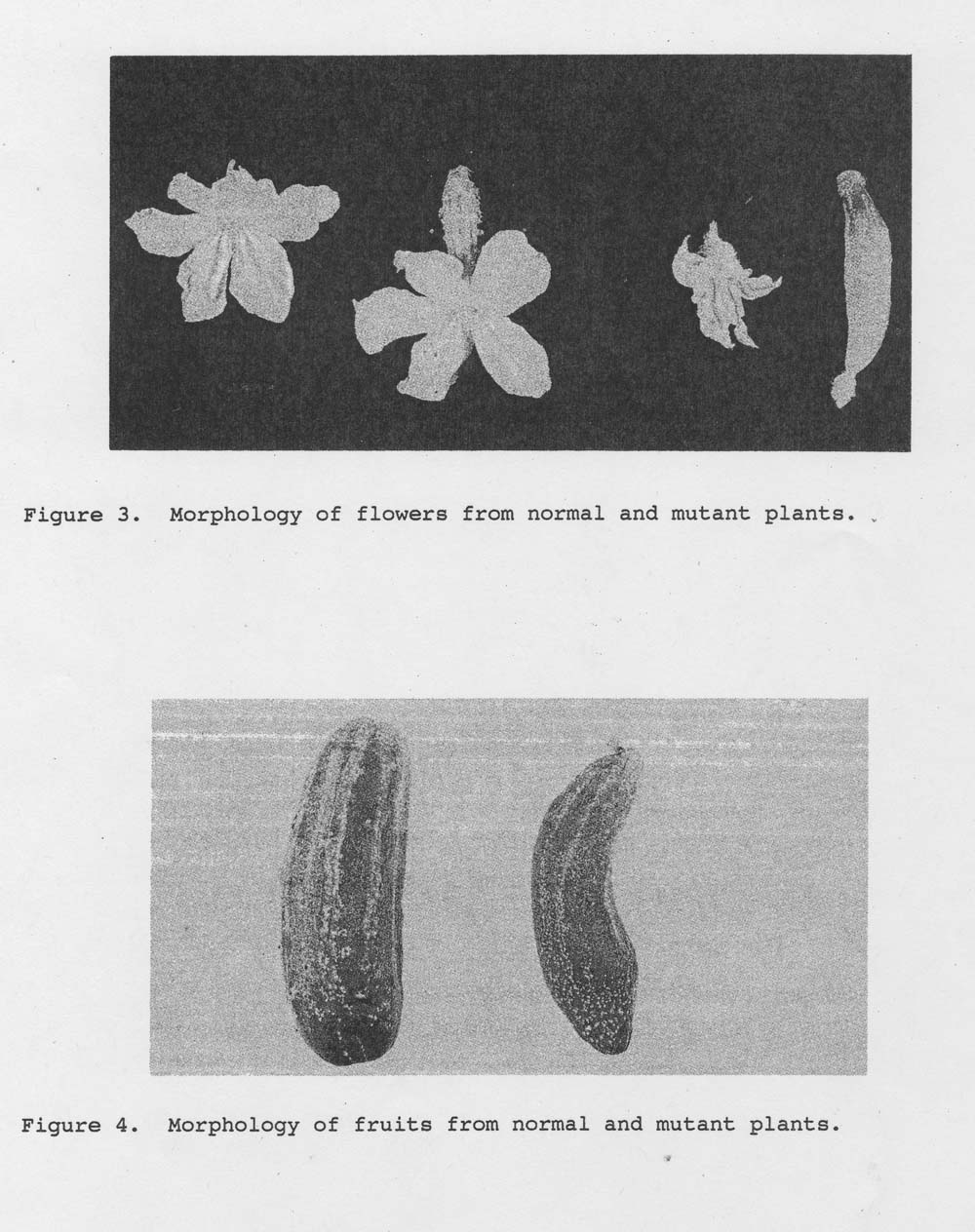Cucurbit Genetics Cooperative Report 16:14-17 (article 6) 1993
M. Rucinska, E. Bergier, K. Niemirowicz-Szcytt and A. Korzeniewska
Department of Genetics and Horticultural Plant Breeding, Warsaw Agricultural University, SGGW, 02-766 Warsaw, Poland
A Phaseolus leaf mutation, along with other previously described cucumber nmutants produced in our laboratory (1, 2, 3), was obtained by chemical mutagenesis. As far as wel know no similar mutation has been described or listed in the CGC cucumber gene list.
This mutant has been generatively reproduced in our laboratory for several years and since it was derived from inbred Borszczagowski line, this was the line used to obtain subsequent generations. While the mutant’s morphological description was bsed on 25 plants, genetic analysis of its inheritance utilized as several hundred individuals. The results of the genetic analysis were analyzed by chi-square contingency tests.
The mutant is detectable at the cotyledons and the first true leaf stage. Cotyledons are small, dark green with violet endings and frequently have a characteristic light spot which appears in the middle. The development of cotyledons is slightly retarded, ebcause the seed coat is not easily separated from the emerging hypocotyl. Mutant plants are smaller than the standard (mutant – 83.5 to 152 cm and standard – 225 to 366 cm) with a smaller number of internodes (mutant = 9-26 and standard = 32-40) (Fig. 1). Mutant leaves are delicate, wrinkled at the end of the main vine, and the leaf margins are undulating and curled (Fig. 2). In most cases leaf blades are not serrated and as such deformations make them appear heart-shaped. The size of the mutant leaf is slightly smaller than that of the standard (mutant leaves = 14 to 16 cm long, and 13 to 17 cm wide with leaf petiole 8 to 12 cm long, while the respective standard dimensions = 19 to 26, 20 to 25 and 12 to 15 cm).
Mutant flowers are remarkably different from those of standard cucumber types (Fig. 3). Mutant plants bare either small and deformed or completely reduced petals. Mutant flowers are reminiscent of flowers in the Labiateae family. Most female flowers are sterile. As common in standard types, more male than female flowers are developed on the plant. The mutant usually sets fruits but they are often deformed and seedless (Fig. 4). As in the standard, mature fruits are brown in color, however the epidermis is not netted.
Following rhe results of the genetic analysis, it is possible to state that a single recessive gene (phl – phaseolus leaf) condition the morphological phenotype described above (Table 1).
Table 1. Inheritance of phaseolus-type leaf (phl)
No. observed |
No. expected |
Ratio testedratio |
X² |
P |
|||
Generation |
Normal |
Mutated |
Normal |
Mutated |
|||
| P1 (normal | 30 | 0 | 30 | 0 | 1:0 | — | — |
| P2 (mutated) | 0 | 25 | 0 | 25 | 0:1 | — | — |
| F1 | 40 | 0 | 40 | 0 | 1:0 | — | — |
| F2 | 335 | 101 | 327 | 109 | 3:1 | 0.78 | 0.50-0/80 |
| F1 x P1 | 83 | 0 | 83 | 0 | 1:0 | — | — |
| F1 x P2 | 124 | 116 | 120 | 120 | 1:1 | 0.26 | 0.50-0.80 |
Figure 1. Cucumber plant posessing Phaseolus leaf mutant.
Figure 2. Comparison of a Phaseolus mutant and standard leaf.

Figure 3. Comparison of female and male flowers from Phaseolus mutant (left) and standard (right) cucumber plants.
Figure 4. A deformed fruit from a Phaseolus mutant (left) compared to the typical fruit from Borszczagowski.

Literature Cited
- Rucinska, M. K. Niemirowica-Szctt and A. Korzeniewska. 1991. A cucumber (Cucumis sativus L.) mutant with yellow stem and leaf petioles. Cucurbit Genet. Coop. Rpt. 14:8-9.
- Rucinska, M., K. Niemirowica-Szcytt and A. Korzeniewska. 1992. Cucumber (Cucumis sativus L.) induced mutations. II. Short petioles mutations. Cucurbit Genet. Coop. Rpt. 15: this volume.
- Rucinska, M., K. Niemirowica-Szcytt and A. Korzeniewska. 1992. Cucumber (Cucumis sativus L.) induced mutations. III and IV. divided and ginko leaves. Fifth Eucarpia Cucurbitaceae Symposium, Poland. July 27-31, 1992. pp. 66-69.